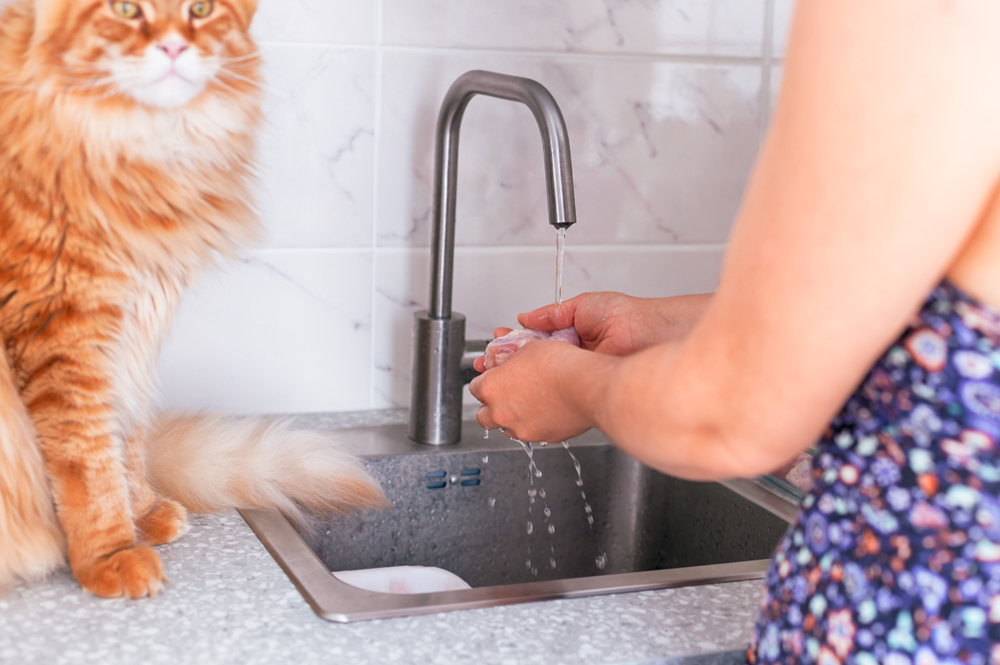Do you raise an eyebrow when your Collie coughs, or your Siamese lets out a tiny sneeze? Do recent worldwide events have you questioning whether every little action is a potential contagion? Although many diseases are capable of animal to human (i.e., zoonotic) transmission, you’ll be relieved to know that few are of serious concern. So, before you lean away from your Labrador or stop scooping your Poodle’s poop—check out Emerald Animal Hospital’s guide to common zoonotic diseases.
Zoonotic diseases—pet to person risk assessment
Zoonotic diseases are considered low-risk for the average healthy adult or child practicing good, basic hygiene. Immunocompromised individuals (e.g., those chronically ill, with autoimmune disorders, or taking immune-suppressing medications, and pregnant women) may have a slightly higher infection risk. While extra precautions are necessary, vulnerable individuals can continue to safely live and interact with their pets, and should not feel forced to give them up.
Zoonotic intestinal parasites in pets
Zoonotic diseases can be viral, bacterial, protozoal, or parasitic. Pets may or may not appear outwardly sick, so using good hygiene when interacting with animals or after handling any waste, bowls, toys, or other pet items is always important. The most common transmission routes for zoonoses include:
- Contact with contaminated body fluids (i.e., urine, feces, or saliva)
- Bite wounds
- Direct skin contact
Familiarizing yourself with the most common zoonotic diseases can help you protect yourself and other household members, and to understand how preventive care can minimize your pet’s risks.
Viral zoonotic diseases in pets
Rabies virus is an acute, progressive disease that moves through the nerves to the brain. Once clinical signs appear—which may take up to 10 days—the virus is always fatal in all mammals, including humans. Rabies is transmitted through the broken skin of a bite wound, when the rabid animal’s saliva is inoculated into the soft tissue.
Vaccinating your pet against rabies is not only for their safety, but also for public health. Although routine vaccination of dogs, cats, and ferrets has helped reduce rabies in the United States, the virus is always present—especially in wildlife. In 2021 alone, five Americans died from rabies, which was the highest annual rate in more than a decade. While post-exposure vaccines given before signs appear can protect infected humans, vaccines for animals are only pre-exposure, so keeping your pet up to date at Emerald Animal Hospital is vital.
Bacterial zoonotic diseases in pets
Bacterial zoonoses are common to pets, and include familiar names such as:
- Salmonella
- E.coli
- Campylobacter
- Pasteurella
- Cat scratch disease (Bartonella henselae)
- Leptospirosis
In addition to dogs and cats, some of these bacteria may be transmitted by goats, sheep, small mammals (e.g., rabbits, rodents), reptiles, and avians. While pets harboring zoonotic bacteria may not be visibly sick, people can become severely ill. Medical treatment is often necessary for bacterial zoonotic diseases.
Zoonotic intestinal parasites in pets
Fortunately, although many intestinal parasites are transmissible, infection is rare. That’s comforting, because this category includes some stomach-turning organisms, including:
- Roundworms
- Hookworms
- Giardia
- Cryptosporidium (coccidia)
- Toxoplasma
Children are at an increased risk for intestinal parasites, because of environmental exposure and less frequent hand washing. Intestinal parasites are most commonly obtained through fecal-oral contact, which can occur after touching infected objects or handling pet waste, and then touching your face or food with unwashed hands. Prompt pet waste removal from the yard or litter box, plus good hygiene measures, can significantly reduce transmission risk.
External parasites in pets
In general, external parasites prefer to remain on their host. However, close contact or infestation can cause parasites to “jump ship” to you. Zoonotic external parasites include:
- Fleas
- Ticks
- Sarcoptic mange (i.e., scabies)
External parasites are not only an uncomfortable nuisance, but can also transmit illnesses, such as tick-borne Lyme disease. Keeping your pet on a year-round flea and tick prevention protocol can effectively stop the potential for shared parasites, but environmental management (i.e., raking leaves, removing brush, checking for ticks after an outing in the woods) is still necessary.
Safe practices to prevent getting diseases from your pet

Staying vigilant about your pet’s health, plus basic hygiene and cleanliness, are zoonotic disease prevention cornerstones. With these simple, easy-to-follow steps, you should feel safe to snuggle your Siamese or smooch your pooch—but maybe not on the lips this time.
- Handwashing — Wash your hands after every interaction with your pet, such as handling pet belongings or waste, and before eating or touching your face.
- Keep pets on year-round flea, tick, and heartworm preventives — Most heartworm preventives include a broad spectrum dewormer, which will keep your pet free from intestinal worms.
- Vaccinate your pet — Routine vaccinations, including rabies, bolster the immune system and protect your pet.
- Test your pet for intestinal parasites every 6 to 12 months — Fecal screenings check for giardia, coccidia, and intestinal parasites.
- Waste removal and disposal — Fresh feces is less infectious, so try to remove solid waste as soon as possible, using gloves, baggies, or a scoop. If possible, at-risk individuals should have someone else clean the litter box.
- Keep your yard tidy — Good landscaping can deter ticks and fleas from inhabiting your yard. Cover sandboxes to protect them from roaming cats. Remove wildlife feeders to reduce potential disease exposure.
Animal-to-human disease transmission deserves increased awareness and respect, but shouldn’t make you fear your furry friend. Regular wellness care at Emerald Animal Hospital, and some common-sense hygiene and home care methods, are all that is needed, to ensure the intense bond between pet and owner is closer than ever. Contact us with any additional questions, or to schedule your pet’s wellness appointment.









Leave A Comment